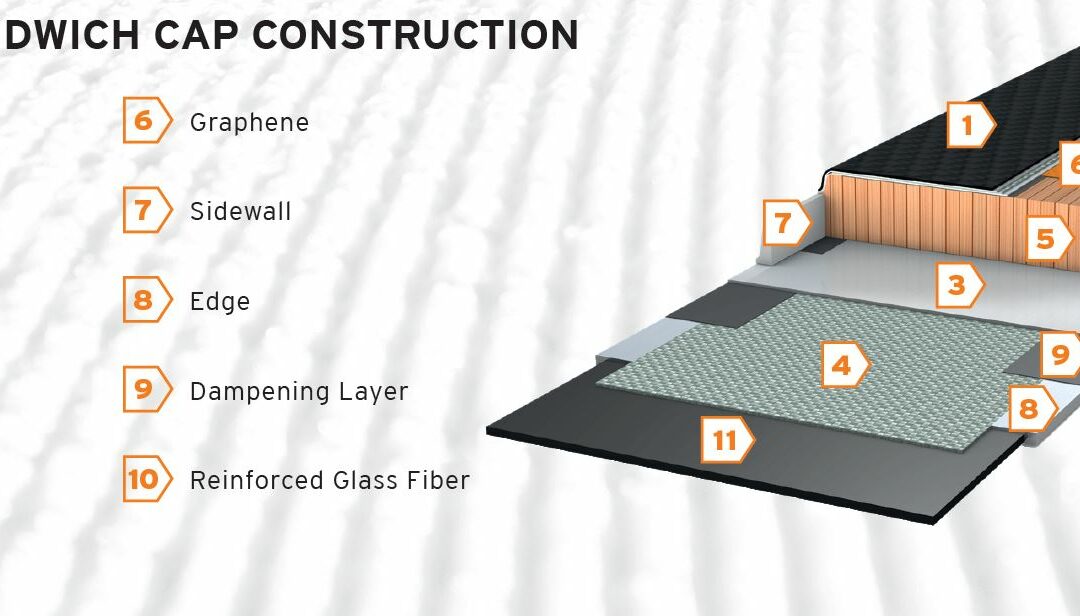
Everything that goes into a ski affects how the final product behaves on snow. Any change in any part, either in what it’s made of or how it’s assembled, affects the whole. Construction shown here is used by Head for its Supershape collection of exceptional carvers.
Every Alpine ski brand is under pressure to introduce new models every year, a process that rotates through the entire line over the course of several seasons. In any given year, either a new model family or a refresh of an existing clan will give each brand something new to promote to a public that is always interested in game improvement.
As I peruse all that is proclaimed as new for 22/23, several trends are evident:
- A lot of models that are justifiably proclaimed as new are adaptations of existing skis.
- The category with the most new models is Big Mountain (101mm – 113mm underfoot), due to the vagaries of a product renewal cycle that is coincidentally completely out of step with the weather.
- All-Mountain East (85mm-94mm) has the next largest collection of new models in a genre that is far more important commercially than Big Mountain. It’s a good sign to see investment where most skiers can benefit from it.
- The pressure to occupy every conceivable niche drives the major brands to create evermore sub-genres, particularly for the off-piste or backcountry skier.
- The Race world operates by its own rule book. The search for speed is never ending.
- Americans are still besotted with the idea of skiing powder. Almost every new ski for 22/23 is built on an off-piste foundation, yet most will probably spend 80% of their lives on groomers.
What Qualifies as New?
It’s axiomatic that everything that goes into a ski matters. Therefore, anytime any component is altered, added or eliminated, the ski is likely to behave differently, however subtly. The evidence of this truism is most apparent during prototype testing in the latter stages of development, when minor variations are compared on snow to find the best final formula.
The 22/23 Alpine market provides several different examples of how to execute a model upgrade, with impacts that vary from subtle to significant. On the subtle side, Blizzard slightly shaved the core profile of the Bonafide 97, Brahma 88 and Brahma 82. This makes them a skosh easier to bend and therefore livelier, but the essential character of this trio remains intact.
K2 changed the configuration of its Titanal Y-Beam in its Mindbender series, adding more metal and in the process raising the performance ante appreciably. The K2 hallmarks of ease and forgiveness haven’t been compromised one iota, but the edge grip and overall hard snow performance has made a major move in the right direction.
Salomon also used a change in core construction, to the QST 92 and QST 106, to take already popular models to a new performance level. As is the case with the other examples cited above, Salomon substantially expanded the performance envelope of its newest iterations without changing their accessibility to lower skill skiers.
Head switched the topsheet on its 22/23 Kore models from fleece to more nick-resistant urethane. The Kore line’s core values didn’t change, but how supportive the ride feels in variable snow conditions and how well it holds on hard snow are likely to be enhanced. A more significant overhaul was applied to Head’s new Shape series, built on the bones of the retired V-Shape collection. The focus of the series is still super lightweight design for Frontside skiing, but a new, stiffer chassis and the addition of the Energy Management Circuit shock-damping system dramatically elevate the performance of its top 3 models.
When Völkl introduced Tailored Titanal Frame and Tailored Carbon Tip in the Mantra M6 this season, it was foreordained that the same game-changing technology would be applied to the Kendo 88 and Mantra 102. Both models have indeed benefited from the upgrades, with the Mantra 102 emerging as a surprisingly mellower, more playful ski than its old namesake.
The changes to both the Sender/Rallybird series at Rossignol and Ranger collection at Fischer are so pervasive that I wouldn’t consider them upgrades, but new collections under established names. Both Dispatch from K2 and Unleashed from Nordica are brand, spanking new off-piste skis that occupy a freshly minted space between hefty all-mountain models and superlight Alpine Touring skis.
The Big Picture
What this superficial survey of next season’s nouveautés reveals is that we’re living in an age of incremental innovations. Adopting a bold new idea that would require wall-to-wall re-tooling isn’t likely to fly very far in the boardroom. The number one mandate is survival, which makes the economics of maintaining manageable R&D and manufacturing costs a higher priority than dazzling technology the market might not be willing to pay for.
The issue of maintaining a desirable return on investment is complicated by the fact that rapidly rising distribution costs are likely to erode what small gains in gross margin were made by modestly raising wholesale prices for next year. With suppliers reluctant to make a major move in suggested retail price, the only way a ski maker can make a significant jump in earnings is by cutting out the middleman, more commonly referred to in these quarters as specialty shops. Hence the increased emphasis on the part of virtually all ski suppliers on direct-to-consumer communication, with the expectation that it will lead to high-margin, direct-to-consumer sales.
Further complicating the ski maker’s calculus for how to spend precious R&D dollars is the chase to create new categories. If you can conceive of a new skier type, then you can create a new ski or two just for him or her, generating a new income stream. Nowhere have more new skier types been identified than in the ever-expanding backcountry market. The murky boundary between in-resort powder skiing and ex-resort hike-to-ski touring has already spawned 3-model families from Nordica and K2. The confluence of off-trail adventure and Pipe & Park trickery has produced its own hybrid genus, populated by such new models as the Atomic Bent Chetler 90 and Dynastar M-Free 90.
Feeding all these new babies requires capital investment, reducing what’s left in the kitty for other projects. With costs for raw materials, energy and transportation skyrocketing, grand plans for introducing totally new technology, with all its inherent added costs, aren’t likely to fly very far. For the foreseeable future, it’s more likely that brands will look for ways to cut costs, a phenomenon that is already underway, rather than try to sway the market with a story of (expensive) product superiority.

